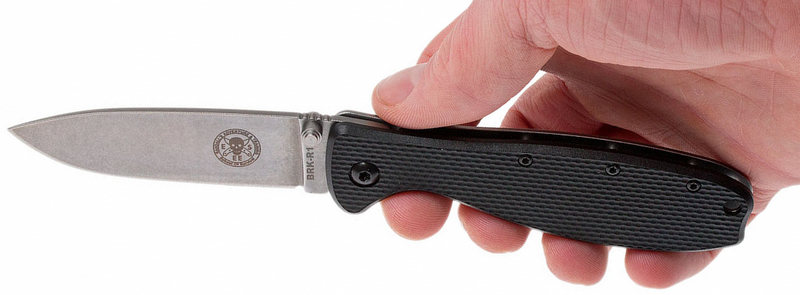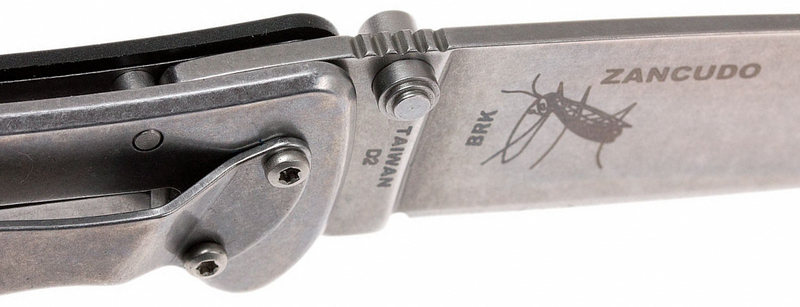We independently evaluate all recommended products and services. Any products or services put forward appear in no particular order. If you click on links we provide, we may receive compensation.
Typically, knives are one of the few straightforward things in life. They don’t require a ton of sleuthing and extensive googling and head scratching to figure out the basics – who designed it, who made it, etc. Take the Kershaw Leek, for example. Can’t be any clearer. Ken Onion designed it, Kershaw made it, you bought it. I can’t say the same about the ESEE Zancudo – or rather, BRK Zancudo. Or RAT Zancudo. Or… umm.

This gets confusing because Ontario Knife Company (OKC) also makes a well-known series of knives called Ontario RAT’s which are – Randall’s Adventure & Training knives, designed by Randall and Perrin as well. The Ontario knives actually predate ESEE – they originally had Ontario making knives to their own specs but later decided to branch off and start their own brand for equipment, but OKC still produces the RAT series of fixed blades and folders as well.
That’s confusing? Well, get this: ESEE doesn’t even make the Zancudo, and its larger brother the Avispa. They were designed by ESEE for Blue Ridge Knives (BRK), a wholesale distributor in Virginia. They’re actually made by Proceeding Manufacture in Taiwan… which, apparently, is also the OEM for the Ontarior RAT 1 & 2. Confused yet? Me too. Just think of them as brothers from other mothers. Or whatever.
Key Specs: ESEE Zancudo
What about the name? Well, Zancudo is a Spanish word referring to a particularly long-legged mosquito. Its big brother the Avispa is Spanish for “wasp.”
The Blade
The Zancudo is available with two different blade steels, with a whole $6(!) or so separating them. Both have the same dimensions, a hair under 3” long with a 2.75” cutting edge, cut from relatively thin 0.09” blade stock. The standard Zancudo uses AUS-8 steel, while my test sample uses D2 steel. The differences are significant and you may want to consider what you’re doing with the knife before picking one for purchase. D2 has a little more than double the carbon content of AUS-8, which means it will have significantly better edge retention and hardness than AUS-8, but it also has a good bit less Chromium – at 11.5%, it’s below the threshold of what is normally considered a “stainless” steel. It won’t rust like 1095 or M4 (which is only 4%!) but it will take a patina much easier and will discolor if you use it to cut acidic foods or scrape battery acid.
 Neither are overly hard to sharpen, and indeed the Zancudo came with a fantastic edge from the factory. The blade shape is easy to love because it’s simple- anyone that’s ever used a Swiss Army Knife will find it familiar! It’s a nearly symmetrical drop point, meaning the tip is just barely above the centerline of the blade, with a full flat grind for maximum slicing potential.
Neither are overly hard to sharpen, and indeed the Zancudo came with a fantastic edge from the factory. The blade shape is easy to love because it’s simple- anyone that’s ever used a Swiss Army Knife will find it familiar! It’s a nearly symmetrical drop point, meaning the tip is just barely above the centerline of the blade, with a full flat grind for maximum slicing potential.
It’s nothing elaborate, but ESEE paid attention to the details on this blade and it shows: the edge was perfectly symmetrical, there’s a smooth stonewash finish (which is unusual at this price point) to hide scratches and reduce corrosion, and there’s a tiny sharpening choil up against the ricasso allowing you to sharpen the whole edge. The thumbstud being mounted all the way up against the bolster on the ricasso means that it won’t get caught on anything you’re cutting through, which is a common downside to thumb stud knives. There’s also a short run of jimping right above the thumb stud which gives you a little more grip. Factory sharpness was admirable, with a very cleanly applied edge bevel that’s even if a little on the grainy side.
There’s also a lot of branding on the blade, the most amusing of which has to be the “Zancudo” figure etched on the lock side, an anthropomorphized mosquito that has the body of the knife itself, a neat little piece of art. The ESEE symbol is etched on the opposite side, along with a BRK part number.
Deployment and Lockup
 Here is, frankly, where the Zancudo faltered where I expected it to flourish. It uses a stainless steel frame lock, and it suffers from a number of problems: entirely too stiff of a detent, minor lock stick and very high lock bar tension coupled with difficult access to release the lockbar, and also noticeable vertical blade play (or “lock rock”) that developed over two months of relatively mild use.
Here is, frankly, where the Zancudo faltered where I expected it to flourish. It uses a stainless steel frame lock, and it suffers from a number of problems: entirely too stiff of a detent, minor lock stick and very high lock bar tension coupled with difficult access to release the lockbar, and also noticeable vertical blade play (or “lock rock”) that developed over two months of relatively mild use.
The detent is so stiff on the Zancudo, an opinion I’m not alone in having – Nick Shabazz mentioned the same thing in his review a while ago. When I first received the knife it was almost unpleasant to open, requiring you to really dig into the thumb stud at an angle and put a lot of grunt on it to open, which gradually chewed up the tip of my thumb over the course of a week – a problem I, as a certified knife lunatic, haven’t had in many years with my seriously calloused thumb! It’s hard to blame the thumb stud for this issue, being a pretty standard “terraced” thumb stud (that’s ambidextrous if you’re a southpaw) and not a professional thumb destroyer like the Kershaw Blur.
Unusually for a stainless framelock, the Zancudo frequently exhibited notable lock stick and difficulty disengaging the lock when it was flicked open, especially during the initial break-in period. This was expounded by the difficult-to-access lockbar, which is basically parallel with the show side scale – similar to the controversial Spyderco Gayle Bradley folder.
Lockup was initially fine but soon started to develop vertical blade play – but strangely, no horizontal play, pointing to there being some flex in the lock bar at the far end. It could also be due to an issue with the geometry where the lock bar contacts the tang of the blade, but regardless it’s unnerving and makes you less comfortable using the knife on a daily basis.
Deployment is actually pretty good once it breaks in, though. One interesting thing about the Zancudo is that it uses four washers: two phosphor-bronze primary washers and then a pair of paper-thin Teflon washers in between the bronze washers and the liners/frame. This gives the Zancudo a smooth, hydraulic feel when you’re rolling it open, or a fast deployment when you flip it open with your thumb. The positioning of the thumb stud relative to the handle in the closed position means it can be difficult for people with fat thumbs (your author included) to get a proper angle on the stud and make opening difficult at times.
Features, Fit & Finish
The build on the Zancudo puts an emphasis on a slim profile and the result is an exceptionally light knife, considering the materials: 3.06 ounces for a folder with a full stainless lock side, and a nested liner on the show side is pretty impressive considering the overall length of 7.” The nested liner on the show side is solid, but fits entirely within the scale which is made out of molded composite. The scale itself is nice: it has a radiused outer edge for a more comfortable grip and small texturing for better traction, and manages to not feel “cheap” like a lot of FRN handles do.

Construction on the Zancudo is flow-through, with a series of plain tubular standoffs supporting the handle. An external stop pin is anchored by the liner/lock side, eliminating any strength worries associated with an internal stop pin – the Zancudo is built with a lot of the techniques normally associated with larger knives. The pivot is a Chicago screw- meaning you only adjust it from one side – which is D-shaped on the barrel side and is secured by the lock side scale to prevent the pivot from rotating when you’re adjusting the tension. The body screws are black on the show side and unpainted on the lock side to better match the contrasting handle colors, a nice touch.
The pocket clip on the Zancudo looks familiar – it has the same offset two-hole mounting plate that’s used on the Kershaw Blur and Leek, but upon further examination it’s not the same part. It has a more pronounced dip at the end and is a slightly different shape overall, but you can tell where the inspiration came from. It has a steep round dip at the end for the contact point, enabling it to easily slide in and out of a pocket while still having strong retention. The clip is configured for tip up or tip down right hand carry, as there are no holes tapped on the FRN scale.

Fit and finish on the Zancudo (well, outside of the issues with the lock and detent) aren’t bad considering the price. No one is going to mistake it for a new Chris Reeve model, but the molded scale is well made, all of the screws sit level with the handles when tightened down, the ambidextrous thumb studs are of two different lengths to match the separate depths of the handles on each side perfectly (a nice touch!), and the stonewash on the blade is attractive and functional especially compared to the bead blast finish most knives at this price range have. The stonewash continues to the lock side of the scale as well as the clip, which is another surprising detail.
Field Test
The Zancudo comes out of the box with the clip configured for tip down carry, which is odd as most people prefer tip up carry. I will say, it seems like the clip was actually designed primarily for tip down carry as much less of the knife sticks out of your pocket in that configuration, but in addition to tip up being irritating (to me at least) the clip also creates an uncomfortable grip. Because the knife is so thin, it makes the Zancudo feel much wider in hand. Flipping the clip alleviates this issue.

Boy does this thing cut, though. Can we get more knives like this and less… well, not to point fingers, but less weird stuff that doesn’t cut worth a crap? It’s a joy to cut stuff with the Zancudo – 0.09” thin, full flat grind, stonewashed blade that offers no friction, no thumb stud in the way of the cutting path, a drop point shape that pierces and slices well. The Zancudo is sort of like a cut-rate Chaparral that puts a focus on the blade working like knives actually are supposed to, instead of ridiculous pretenses of “hard use!” that leave you with a folding axe that ruins the sandwich you’re trying to cut.
It carries well, too. The super thin profile and short spine-to-handle depth when closed makes this one disappear in the pocket, and the long clip to handle ratio means it stays put very well. You forget it’s there. They could do to mount the clip a little closer to the end of the handle in tip-up configuration, but that’s no big deal.
Ergonomics are decent. There’s no forward finger choil, but the “pinched” portion of the handle towards the pivot does a good job of locating your hand positively and the flare towards the end fills your palm effectively. The only jimping to be found anywhere on this knife is on the ricasso above the thumb stud, giving your thumb a place to perch when you’re pushing down.

D2 is a great steel despite its age. The Zancudo came admirably sharp out of the box but with a little time on the Spyderco Sharpmaker it got an absolutely stupendous edge. D2 seems much less prone to chipping than more brittle steels like S30V in my time using it, with the edge getting noticeably dull after cutting up a lot of cardboard but not “ragged” looking – and easily restored with a few minutes on the fine stones. It is prone to discoloration from cutting acidic foods or things like that due to its chemical composition, but not to the degree of high carbon steels like M4 or 1095.
Of course, in a “besides that Mrs. Lincoln, how did you enjoy the play?” sort of way, the combination of problems with the detent, lock bar tension, lock rock, and thumb-destroying thumb stud sort of ruin the use experience of what would otherwise be an excellent knife. You end up finding yourself using the knife less because it’s so unpleasant to open and the rocking blade doesn’t inspire any sort of confidence.
Alternatives
All these knives available at BladeHQ.
The most obvious alternative to the Zancudo is the Ontario RAT Model 2 in D2 tool steel. At the time of writing, the Zancudo is $35 on BladeHQ and the “R2D2” is $38, meaning near-enough no difference. It’s also available with a faux carbon fiber scale for $48 that you shouldn’t even entertain buying because, ugh. These are made from the same materials, likely by the same OEM in the same plant, probably even next to each other. The main difference is the lock and the blade shape; the RAT is a drop point but with a higher center axis and more belly. It also uses a stainless liner lock that is less prone to the issues the Zancudo experienced, and while it is thicker it offers the option of a four-position clip. It’s slightly lighter at 2.75 ounces, due to not having a full stainless lock side.
If you’re more after a flipper, the Steel Will Cutjack Mini in FRN and D2 is basically the same formula but a slightly different recipe. It uses D2 steel with a satin finish, a flipper with phosphor bronze washers (when was the last time you used a flipper that wasn’t on bearings or assisted?) and textured FRN over skeletonized stainless liners. Like the RAT and the Zancudo (with the Avispa) the Cutjack is also available in a larger 3.5” format. Retail is currently $40.

Kizer’s Vanguard line is priced a little higher than these options, but their recently introduced Tangram sub-brand which is available on Amazon has some extremely good value knives. They all use “Acuto 440” steel which is basically 440C stainless with additional amounts of chromium and vanadium for increased performance. The Tangram Santa Fe is $30(!), Prime-eligible, and has G10 handle scales with a reversible tip-up deep carry clip. A modified wharncliffe blade shape coming in at 3” looks to be great for utility purposes, and being a Kizer product it should be well put-together.

Most Kershaws at this price point are long on looks and short on performance, but if you’re willing to sharpen more often for some neat features then the new Anso-designed Fraxion is worth a look. At only $30 it’s surprising that it offers a KVT ball-bearing pivot, and G10 handles with carbon fiber overlays. There’s also the domestically-produced Link which is a well put together knife for $35, but the downside is the 420HC steel – quite a few steps behind D2 in terms of performance for the money.
Wrap-up
The Zancudo was a product I really, really wanted to like. It looks great with good materials at an affordable price. It’s remarkably thin in the pocket, but still has solid ergonomics when you’re using it. It’s light. Hell, it’s even got a cool back story.
And there are things to recommend the Zancudo, primarily the fantastic blade shape which puts a solid focus on functionality. This knife cuts surprisingly well considering the ultra-low price point. The stonewash finish on the blade and the lock side is a nice touch, and at a casual glance it seems well put together.
But the issues with the blade play stemming from the lock, as well as the overly stiff lockbar and detent make this one a no-go for me. I’d like to think this is an isolated incident with regards to the quality of this knife; even then I think I’d prefer the liner-lock of the RAT Model II over the Zancudo in the first place, or the slick Cutjack. Your mileage may vary.
- D2 steel at an affordable price, fantastic blade shape and geometry makes for killer performance, light, thin
- Vertical blade play, overly stiff detent and lockbar tension will tear your thumb up, the RAT Model II and Mini Cutjack exist
ESEE Zancudo
Quality/Performance - 62%
Value for Money - 72%
67%
The ESEE Zancudo represents a good concept with flawed execution and some stiff competition.





